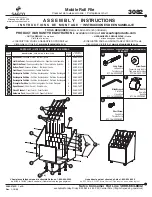
DR
AF
T
6.2 Programming Track Programming
Programming Track programming, also known as Service Mode Programming is a method by which you
can configure a DCC Decoder’s CVs while using a dedicated, isolated track. Connect your isolated
programming track to the black screw terminals on your CS-105.
NOTE: While the Programming Track is in use, the CS-105 will turn off the mainline and all auxiliary
boosters. To avoid unexpected shutdowns, we recommend disabling the Programming Track
Access during operating sessions using DCC System Settings > Advanced > Program Track Access
> unavailable.
The use of a programming track is the only guaranteed way to be able to read back the values of CVs from
a decoder. For more information on mainline programming, please refer to our help article on the subject:
Support - DCC Programming Track - TCS Documentation
11
When entering programming mode from the TCS throttle, the command station will continue to power the
mainline until you actually send a programming command to either read or write a CV. After your first read
or write action, the command station will remain in programming mode for 30 seconds before automatically
exiting and returning to the main. If you send any additional programming commands before the 30 second
timeout, the timer will refresh and begin the countdown again. This method of handling the programming
track is intended to limit downtime of the mainline in the event that an operator does not exit programming
track mode on a larger club layout for example. On the other hand, the timeout provides ample time to allow
for an operator or a program such as JMRI to send additional programming commands if they intend to
program multiple CV’s at the same time.
You can also trigger the timeout to end immediately by exiting the programming menu on the TCS throttle.
Doing so will send a message to the command station to return to the main without any additional input
from the operator. TODO/planned.
6.2.1 Direct Mode Programming
Direct mode programming, also known as “direct bit” or “bit manipulation” programming is a more
time-efficient method of programming a DCC decoder, and is the default programming method used by the
command station. When reading a CV, Direct mode programming works by querying a decoder for the state
of each bit within a CV. The decoder will provide different acknowledgements for 1’s or 0’s within the CV.
The command station can then convert the binary result into a decimal value and display it on the throttle in
a readable way. Any Direct mode programming instruction always takes the same amount of time to
complete, regardless of the CV number or CV value.
To access Direct Mode Programming, you do not need to specially select it. Simply use your TCS throttle
menu and select “Program Track” from the CV Programming menu.
For more technical information on how Direct mode programming works, see
S-9.2.3.
6.2.2 Paged Mode Programming
Paged mode programming is an older, slower method of programming a DCC decoder compared to Direct
Mode Programming (described above). The CS-105 has partial support for Paged Mode programming;
writing a CV is supported, but reading a CV is not.
11
https://docs.tcsdcc.com/wiki/Support_-_DCC_Programming_Track
© 2022 Train Control Systems
Page 25 of 49
















































